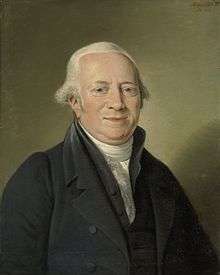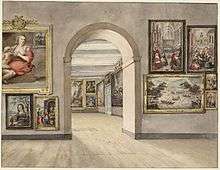Cornelis Sebille Roos
| Cornelis Sebille Roos | |
|---|---|
 Portrait by Adriaan de Lelie | |
| Born |
10 January 1754 Amsterdam |
| Died |
31 January 1820 Amsterdam |
| Nationality | Netherlands |
Cornelis Sebille Roos or Cornelis Roos (1754 – 1820) was a Dutch art dealer and inspector of the Nationale Konst-Gallery collection in Huis ten Bosch during the years 1799-1801[1]
Roos was born in Amsterdam and became a drawing teacher at Felix Meritis, which he helped found.[2] He lived in the left-hand side of the Trippenhuis where he started his art dealership. Many of the paintings he originally purchased have found their way into the collection of the Rijksmuseum.[3] He was friends with Jan Gildemeester and attended the estate sale of his art collection, buying many pieces there that later found their way in the Huis ten Bosch collection. The most notable of these was The Threatened Swan by Jan Asselijn, which became the first painting purchased by the director of the Nationale Konst-Gallery, Alexander Gogel. The painting, which is not dated, was painted before the events which caused it to be marked. It was marked to make it a political allegory of the patriot hero Johan de Witt who was murdered by orangists. Since Roos was known for his patriotic politics, it is quite possible that he marked the painting himself when he bought it in 1800, though the estate sale catalog already mentions that it is an allegory of Johan de Witt.[4]
National art gallery

The Nationale Konst-Gallery opened in Huis ten Bosch in 1800 but moved after the government changeover in 1805 to make room for the new inhabitant of Huis ten Bosch, Rutger Jan Schimmelpenninck. The collection was moved to the former Prince William V Gallery, now part of the museum known as the Gevangenpoort. In 1808 it moved again according to the wishes of Lodewijk Napoleon to the former city hall of Amsterdam. Though Roos lived and worked in Amsterdam, the position of inspector in Amsterdam was given to Cornelis Apostool and Roos went back to his dealership. Roos became a member of the Royal Institute, predecessor to the Royal Netherlands Academy of Arts and Sciences, in 1808.[2] In 1815 this Royal Institute was united with Roos' art dealership as they were in both halves of the Trippenhuis. The entire building became the institute with the first floor devoted to the National Konst-Gallery.
Roos died in Amsterdam. His son Cornelis François Roos continued his art dealership and gallery after his death.[5]
Art collection
-
_Rijksmuseum_SK-A-257.jpeg)
Portrait of Johan van Oldenbarnevelt
-

Portrait of Aechje Claesdr. Pesser
References
- ↑ Cornelis Sebille Roos in the RKD
- 1 2 "Cornelis Sebille Roos (1754 - 1820)". Royal Netherlands Academy of Arts and Sciences. Retrieved 13 May 2016.
- ↑ Cornelis Sebille Roos in Dutch history website "If then is Now"
- ↑ Catalog entry at 1800 purchase for Een Levensgrote Zwaan in een Landschap
- ↑ Son's entry mentioning his father C.S. who did not have an entry himself in the NNBW
